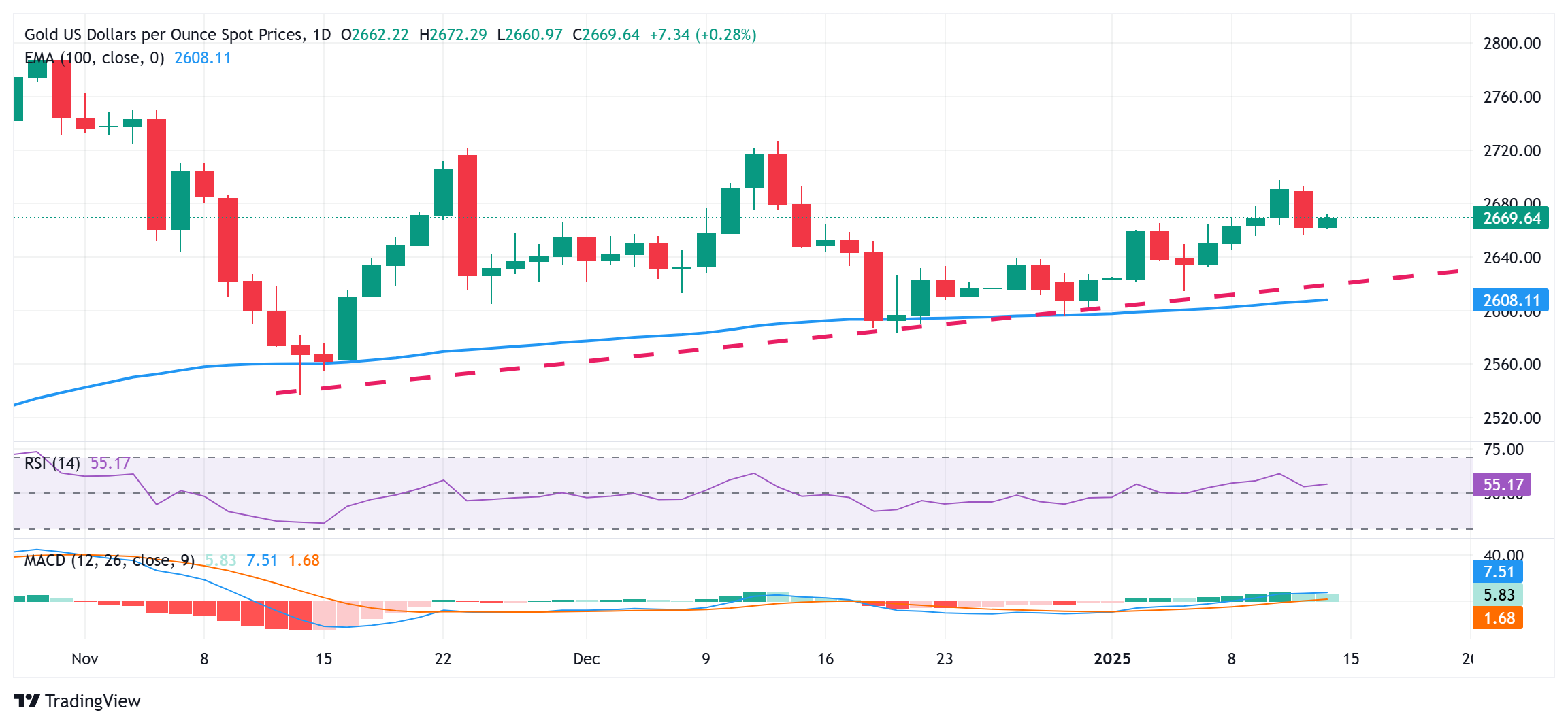Gold sticks to modest intraday gains; lacks bullish conviction amid risk-on mood

- Gold price regains positive traction amid a modest pullback in the US bond yields.
- Hawkish Fed expectations favor the USD bulls and should cap the precious metal.
- The risk-on impulse might further contribute to keeping a lid on the XAU/USD pair.
Gold price (XAU/USD) attracts some dip-buyers on Tuesday, though it lacks follow-through and remains below a one-month top touched the previous day heading into the European session. Reports that US President-elect Donald Trump’s top economic advisers are mulling a slow ramp-up in tariffs to prevent a sudden spike in inflation trigger a modest pullback in the US Treasury bond yields and benefit the non-yielding yellow metal. That said, the Federal Reserve’s (Fed) hawkish shift holds back traders from placing aggressive bullish bets around the commodity and caps gains.
The upbeat US Nonfarm Payrolls (NFP) report released on Friday reinforced bets for a slower pace of interest rate cuts by the US central bank this year. This, in turn, assists the US Dollar (USD) to stall its profit-taking slide from over a two-year peak touched on Monday and should act as a tailwind for the US bond yields. Furthermore, easing fears about disruptive trade tariffs under Trump 2.0 boosts investors’ confidence and contributes to capping the safe-haven Gold price. Traders now look to the US Producer Price Index (PPI) for a fresh impetus later during the North American session.
Gold price is underpinned by sliding US bond yields; Fed’s hawkish shift acts as a headwind
- Bloomberg, citing people familiar with the matter, reported on Monday that President-elect Donald Trump’s economic advisers are considering a program to gradually increase tariffs month by month.
- The approach, aimed at boosting negotiating leverage and helping avoid a sudden spike in inflation, triggers a modest pullback in the US Treasury bond yields and revives demand for the Gold price.
- The sizzling US job report cemented expectations the Federal Reserve will proceed with caution while cutting rates this year, which helps the US Dollar to stall Monday’s pullback from over a two-year high.
- The Fed’s hawkish outlook should also limit the benchmark 10-year US Treasury bond yields’ corrective slide from a 14-month high and keep a lid on any further gains for the non-yielding yellow metal.
- US President-elect Donald Trump has repeatedly promised to end the conflict in Ukraine and said that he will meet Russian President Vladimir Putin “very quickly” after he takes office next week.
- The US indicated that a ceasefire deal is on the brink of success while Hamas said talks are progressing well. Two Israeli officials said that Hamas will release 33 hostages in the first phase of the ceasefire agreement.
- Investors now look forward to key inflation prints – starting with the Producer Price Index later today, followed by the US consumer inflation figures on Wednesday – for some meaningful impetus.
Gold price is likely to confront stiff resistance near $2,700; bulls retain near-term control
From a technical perspective, any subsequent strength beyond the $2,676-2,677 area is likely to confront some resistance near the $2,690 zone ahead of the $2,700 mark. Some follow-through buying beyond the latter will set the stage for an extension of over a three-week-old uptrend and lift the Gold price to the $2,716-2,717 hurdle en route to the December monthly swing high, around the $2,726 region.
On the flip side, the $2,657-2,656 area, Monday’s low, might continue to protect the immediate downside. A convincing break below, however, could make the Gold price vulnerable to accelerate the downfall towards the $2,635 region. The downward trajectory could extend further towards the $2,610 confluence, comprising the 100-day Exponential Moving Average (SMA) and a multi-week-old ascending trend line.
Risk sentiment FAQs
In the world of financial jargon the two widely used terms “risk-on” and “risk off” refer to the level of risk that investors are willing to stomach during the period referenced. In a “risk-on” market, investors are optimistic about the future and more willing to buy risky assets. In a “risk-off” market investors start to ‘play it safe’ because they are worried about the future, and therefore buy less risky assets that are more certain of bringing a return, even if it is relatively modest.
Typically, during periods of “risk-on”, stock markets will rise, most commodities – except Gold – will also gain in value, since they benefit from a positive growth outlook. The currencies of nations that are heavy commodity exporters strengthen because of increased demand, and Cryptocurrencies rise. In a “risk-off” market, Bonds go up – especially major government Bonds – Gold shines, and safe-haven currencies such as the Japanese Yen, Swiss Franc and US Dollar all benefit.
The Australian Dollar (AUD), the Canadian Dollar (CAD), the New Zealand Dollar (NZD) and minor FX like the Ruble (RUB) and the South African Rand (ZAR), all tend to rise in markets that are “risk-on”. This is because the economies of these currencies are heavily reliant on commodity exports for growth, and commodities tend to rise in price during risk-on periods. This is because investors foresee greater demand for raw materials in the future due to heightened economic activity.
The major currencies that tend to rise during periods of “risk-off” are the US Dollar (USD), the Japanese Yen (JPY) and the Swiss Franc (CHF). The US Dollar, because it is the world’s reserve currency, and because in times of crisis investors buy US government debt, which is seen as safe because the largest economy in the world is unlikely to default. The Yen, from increased demand for Japanese government bonds, because a high proportion are held by domestic investors who are unlikely to dump them – even in a crisis. The Swiss Franc, because strict Swiss banking laws offer investors enhanced capital protection.
